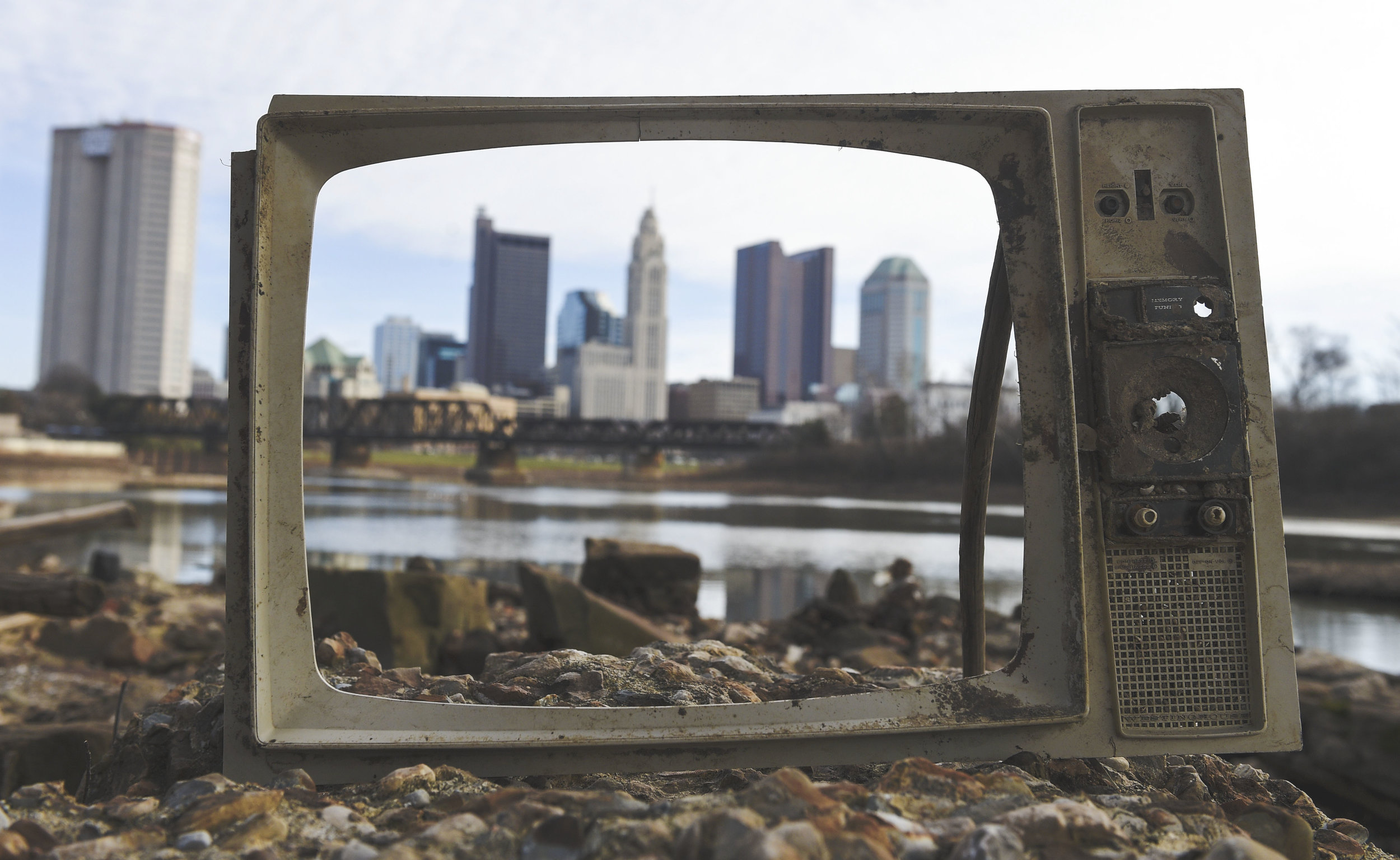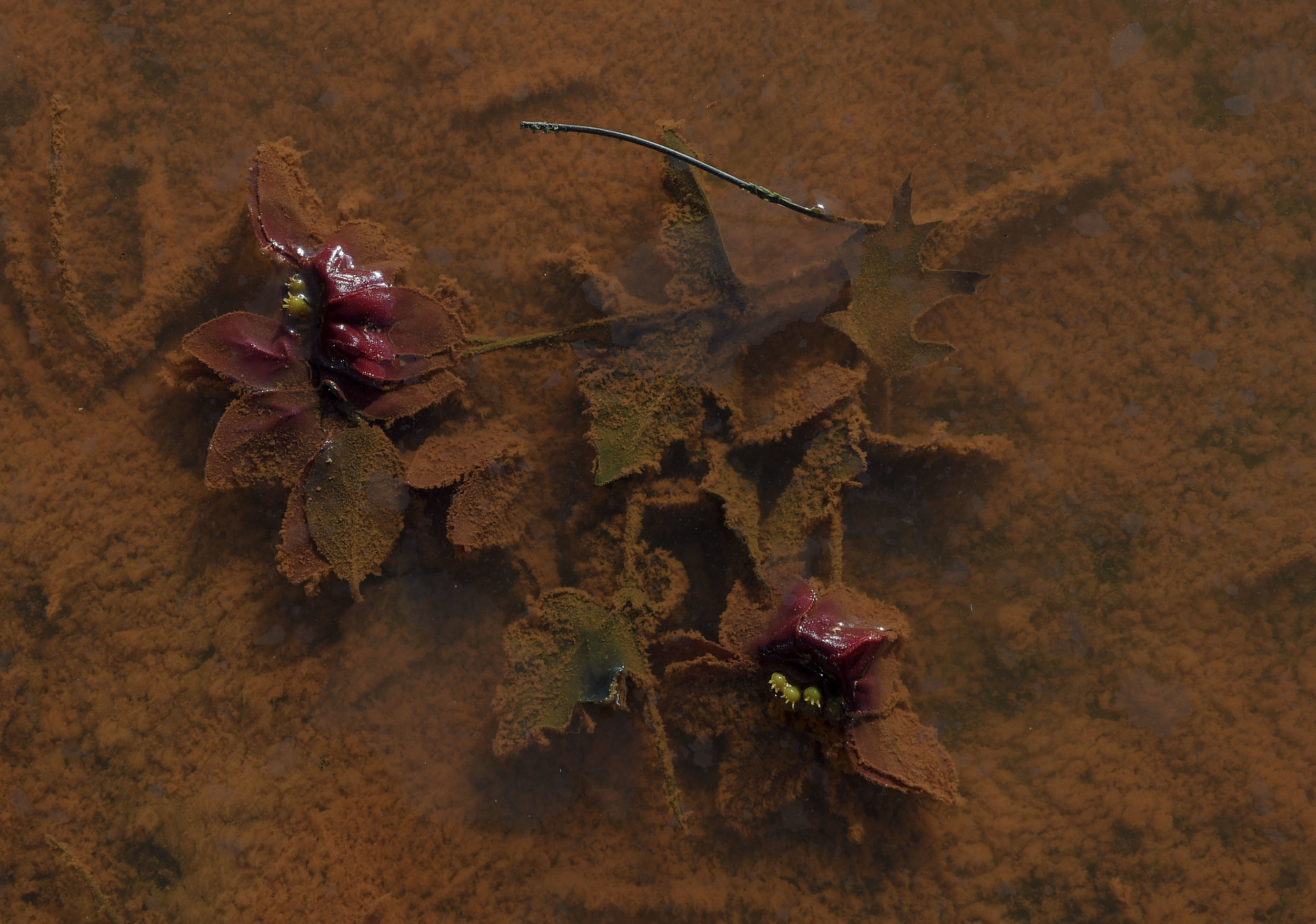Part of larger project documenting pollution in the part of the Scioto River that runs through Columbus, these images were mostly shot in the Winter of 2017. The focus of the project is to highlight the amount of pollution bodies of water in the United States face, using the Scioto River as an example.
The downtown area of Columbus as seen through the remains of an old Television that was propped up on a rock on the eastern shore of the Scioto River.
From high above, at a bird's eye view, the Scioto River looks like a long jagged scar cutting through downtown Columbus. When Lucas Sullivant arrived in what would become Columbus, Ohio in 1797 he erected the first settlement in the area on the Scioto's western bank. Before him the Hopewell tribe built their mounds and villages along its' banks. Throughout the year kayakers and paddle boarders enjoy themselves on the normally calm waters that drift under the Broad Street Bridge and provide a scenic view of the downtown area. After summer rains and winter ice melts however the usually tranquil waters can turn fierce. Sullivant himself witnessed the river's fury as his settlement was wiped out in the late 18th century, and again in the spring of 1913 the neighborhood of Franklinton was nearly wiped out as the Scioto rose and flooded the west side of the city.
The river is now the main source of drinking water for Columbus, Ohio. A new threat looms beneath the chilly waters of the river. Agricultural pollution in the form of fertilizers and pesticides, storm water runoff from the new construction all along the river front, and the trash from generations of Columbus residents finds its way into the rive, threatening its ecosystem as well as the quality of the water itself.
High above in one of the new sky rise apartments the river looks clean and well. Geese float gently along the river, and the new Scioto Mile bustles with activity and radiates beauty; but down on the shores a different story is told. Discarded television sets, a galaxy of litter built over a century, and sewer runoff poison the waters. Invasive species of fish, mollusks, and plant life are creeping in and slowly but surely erasing native species. There is no doubt that the Scioto River of Lucas Sullivant's time is completely different from the Scioto River Columbusites know now. This being known one has to ask, what will the Scioto River look like farther into the future if we don't curb the problems facing it now?
The Scioto River isn't unique in these problems. Worldwide bodies of water such as this big and small face the same threats. Whether a stream or a river, an ocean or a pond, the impacts of humans upon their water sources is long lasting and far reaching. These bodies of water will be here long after we are gone, their future however lies in the present.
A White Heron finds a snack in the quiet waters of Scioto Audobon Metro Park.
Workers start a days labor on the Scioto Mile in Downtown Columbus. The shores of the Scioto Mile, a project completed in 2015 by the city, feature native plants and a restored Scioto River with the removal of the dams that used to interrupt the flow over water through the downtown area. While the efforts to restore the river make some headway, there a many underlying issues facing the river that replanted native plants and dam removal won't fix.
The tracks of a bird in wet mud pass a discarded water bottle on the east shore of the Scioto River.
A mound of trash lay on the east shore of the Scioto River only 50 yards from the newly built Scioto Mile.
Looking down onto the bank of the Scioto River from a bike trail along the Scioto River near where its' largest tributary, the Olentangy River, intercedes it.
Ice creeps onto the surface of the waters where the Olentangy bleeds into the Scioto River a few miles upstream from Downtown Columbus.
Low water levels near the intersection of the Scioto River and Olentangy River reveal dirty secrets hidden beneath the soil at the bottom of the Scioto.
Newly built high rise apartments are reflected in the waters of the Scioto near Confluence Park in Downtown Columbus, Ohio.
Sky scrapers loom in the distance as morning light illuminates an empty whiskey bottle on the west shore of the Scioto River.
The corpse of gull lay next to a discarded tire on the east bank of the Scioto River 20 yards from a sewage runoff that drains into the Scioto River near newly built high rise apartments.
Artificial flowers float in storm water runoff on the east shore of the Scioto River. The orange grime gathering over the soil is Iron Oxidizing bacteria.
The pollution in the Scioto is not unique, nor limited to the rivers and lakes of Ohio. Throughout the world waterways are polluted and concern for the ecosystems and the effect that this pollution has on others is disregarded. What we cast off into these rivers and streams may not affect us in the present, but like every other problem it only gets worse the longer it is neglected. Beneath these waters a rich record of human history is buried, if we don't take action to care more for the resources available to us now, we may not have much more of a future share.
-MH











